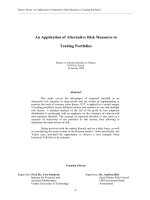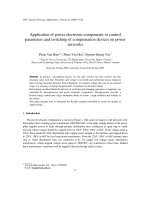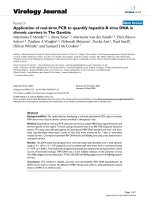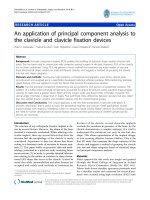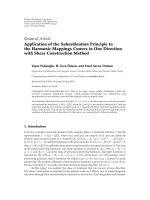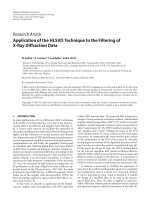Application of Impulse Momentum Theory to Vehicle Collisions
Bạn đang xem bản rút gọn của tài liệu. Xem và tải ngay bản đầy đủ của tài liệu tại đây (159.88 KB, 10 trang )
Tr. J. of Engineering and Environmental Science
23 (1999) , 455 – 464.
¨ ITAK
˙
c TUB
Application of Impulse Momentum Theory to Vehicle Collisions
¨
A. G¨
uven OZTAS
¸
˙
¨
˙ saat Fak¨
Istanbul
Teknik Universitesi,
In¸
ultesi,
˙
Ula¸stırma Anabilim Dalı Maslak, Istanbul-TURKEY
Received 30.04.1999
Abstract
Collisions between two objects are classified into three groups : Linear Central Impacts, Oblique Central
Impacts and Eccentric Impacts. In this paper, the effects of all three types of impacts by motor vehicles are
studied using the theory of impulse and momentum.
The loss of energy caused by impacts is defined by the Coefficient of Restitution “e”. Accordingly, Elastic,
Elastoplastic and Plastic Collisions occur in all 3 types of impact. Oblique Central Impact is observed more
often than Linear Central Impact, and Eccentric Collisions are observed more often than the other two types
in highway collisions. Cases of these types of collision are examined, and examples of all 3 types of collision
adapted to vehicle collisions are illustrated.
Key Words: Accidentology, Collisions, Coefficient of Restitution, Impulse, Momentum.
˙
Impuls-Momentum
Teorisinin Ta¸sıt C
¸ apı¸smalarına Uygulanması
¨
Ozet
C
¸ arpı¸sma noktaları dikkate alındı˘
gında, iki cisim arasında meydana gelen ¸carpı¸smaları, genelde 3 tipte
toplamak olasıdır. Bunlar, Do˘
gru Merkezsel C
¸ arpı¸sma, E˘
gik Merkezsel C
¸ arpı¸sma ve Eksantrik (Merkezden
Ka¸cık) C
¸ arpı¸smalardır. Bu makalede, her u
¨ ¸c c¸arpı¸sma tipinin karayolu ta¸sıt ¸carpı¸smalarına uyarlaması
˙
yapılmı¸s, zorunlu ve gerekli olan bazı kabul ve yakla¸sımlarla, ¸carpı¸smalar teorisinin (Impuls-Momentum
Kanunları) pratikteki uygulaması et¨
ud edilmi¸stir.
C
¸ arpı¸smalar sonucu meydana gelen enerji kaybı, C
¸ arpı¸sma Katsayısı ”e” ile belirlenmekte, buna g¨
ore
de her 3 tipteki ¸carpı¸sma i¸cin Elastik, Elastoplastik ve Plastik ¸carpı¸smalar s¨
oz konusu olmaktadır. Do˘
gru
Merkezsel C
¸ arpı¸smaya kıyasla E˘
gik Merkezsel C
¸ arpı¸sma, her ikisine kıyasla da Eksantrik C
¸ arpı¸sma, karayolundaki trafik kazalarında daha c¸ok g¨
or¨
ulmektedir. Sunulan ¨
ornekler, bu tipler i¸cin hazırlanmı¸s, ayrıca
her u
¨¸c tipteki c¸arpı¸smanın ta¸sıt ¸carpı¸smalarına uyarlanan ¨
ornekleri de ¸sematik resimlerle belirtilmi¸stir.
Kazabilim (Accidentologie) ve Karayolu Trafi˘
ginde G¨
uvenlik a¸cısından, b¨
oylesi bir teoriden hareketle belirli
sonu¸clara ula¸sılmı¸s olmasının, daha ileride bu konuda yapılabilecek ba¸ska ¸calı¸smalara destek sa˘
glayaca˘
gı
umulmaktadır.
˙
Anahtar S¨
ozc¨
ukler: Kazabilim, C
¸ arpı¸smalar, C
¸ arpı¸sma Katsayısı, Impuls,
Momentum.
455
¨
OZTAS
¸
1.
Introduction
Types of vehicle collision on highways can generally be classified as head-on collisions (i.e. accidents due to dangerous overtaking), front-to-back
collisions and eccentric collisions (collisions at crossroads). According to statistics published by the Ministry of Interior Affairs of Turkey, in 1997, 48883
overtaking collisions (17.92 % of total accidents),
74491 front-to-back collisions (27.31 % of total accidents) and 56922 intersection collisions (20.86 % of
total accidents) took place on urban and rural roads
in Turkey. The total of these three figures is 180296
collisions, which is 66 % of the total number of accidents (272774) which occurred in 1997. This is a
significant figure 41.73 % of all these collisions were
fatal and 42.06 % of them resulted only in injuries.
During head-on and front to back collisions, the
symmetry axes of the vehicles are mostly congruent
or parallel to each other. However, in the third case,
eccentric impact, potential results are difficult to predict due to displacements caused by rotation. This is
observed mostly in accidents at intersections. What
is important is the changed directions of the vehicles
after the collision, their displacements and their ultimate positions (overturned, rolled over, displaced,
etc.,).
The intensity of the impact depends on the velocity (vi ) of the vehicle, its mass (mi ) and the material
the vehicle is made of. Consequently, some accidents
may result in greater damage whereas others may
cause only minor damage. More detail can be obtained through analysis of the Impulse-Momentum
Laws.
2. The Impulse-Momentum Theory
2.1.
Linear Central Impact
Linear Central Impact between two objects’ assumes
the following :
a- Objects do not rotate within their axes during
the crash.
d- It is also assumed that both objects are rigid
before and after the collision, but are able to
change shape during the crash, and that the
mass dispersion is not affected by the crash.
e- The impact time ”t” is very short and, therefore, the location of the objects before and after
impact is nearly the same.
m1 and m2 are the masses of the objects; their
velocities before the impact are v1 and v2 , and the
velocities after the impact are v1 and v2 ; F1 and F2
forces exposed during the impact are equal (Newton’s 3 rd Law), but their directions are opposite
(Fig.2).
m1
m2
F2
v2 F1
v1
m2
m1
v'1
v'2
Figure 2. Linear Central Impact.
So:
ti
ti
F1 dt +
0
F2 dt = 0
(1)
0
This impulse integral is equal to momentum:
m1 v1 + m2 v2 = m1 v1 + m2 v2
(2)
In order to analyze this further, it is useful to
divide the Impact Time t into t1 and t2 . (t1 ) is
the compression time and, during this time, the object starts to change shape and reaches its maximum
level, i.e., Force and Reshaping are at a maximum;
after this time, the relative velocity between the objects is zero. (t2 ) is the restitution time and simultaneously the reshaping lessens and finally disappears
(Fig. 3).
F
F
F
b- The normal plane of an impact area passes
through the two objects mass centers (Fig.1).
(b)
(c)
Force
(a)
Figure 1. Linear Central Impact.
c- Velocity vectors at the mass center are on the
collision normal line before the collision.
456
t1
t2
t
t1
t2
t
t1
t
t2=0time
Figure 3. Relations between Force and Time during impact.
¨
OZTAS
¸
F
Force
In the first diagram, t1 = t2 = 1/2t; it corresponds to an Elastic Collision. (Fig. 3a).
In the second diagram, t1 = t2 , and this case is
Inelastic, meaning that it is an Elastoplastic Collision (Fig. 3b).
In the third diagram, t2 becomes zero (t2 = 0),
that means that the objects collide and cannot be
separated. This impact is a Plastic Collision. (Fig.
3c).
The change in momentum is equal to the impulse
integral and the common velocity vc at the beginning
of the restitution time reaches the maximum level.
A1
A2
t
Time
t1
m1 (vc − v1 ) =
F2 dt
Figure 4. Relation between Force (F) and Time (t).
0
t1
m2 (vc − v2 ) =
t1
F1 dt = −
0
This can be written as:
F2 dt
0
m1 v1 + m2 v2
vc =
m1 + m1
During the restitution time t2 , the following is
obtained :
m1 (v1 − vc ) =
m2 (v2 − vc ) =
vc =
m2
(1 + e)(v2 − v1 )
m1 + m2
m1
(1 + e)(v1 − v2 )
v2 = v2 +
m1 + m2
F2 dt
t1
F1 dt = −
t2
F2 dt
(4)
It is necessary to accept the existence of a cort
t
respondence between 0 1 F dt and t12 F dt, which
is called the Coefficient of Restitution, “e”. So this
relation can be formulated as :
t1
F dt = e
t1
(5)
(6)
∆Ec = Kinetic Energy change (Loss).
If the general relation, which is
t1
m1 v1 + m2 v2
m1 + m2
t2
v −v
So; e = − v11 −v22 and so we obtain :
v1 = v1 +
t2
t1
t2
v1 − vc = e(vc − v1 )
v2 − vc = e(vc − v2 )
(3)
F dt (Newton Hypothesis).
0
The Coefficient of Restitution (e) is related to
objects, materials, masses and velocities.
A1 = Area of Compression period.
A2 = Area of Restitution period.
A2
A1 = e In Figure 4:
If e = 1, the impact is Elastic.
If e = 0 ∼ 1, the impact is Elastoplastic.
If e = 0, the impact is Plastic.
∆Ec =
1
1
1
1
m1 v12 + m2 v22 − m1 v12 − m2 v22 (7)
2
2
2
2
is changed with the new values, the following equation is obtained :
1
1 (1 + e)2 m1 m22 (v2 − v1 )2
1
m1 v12 = m1 v12 +
2
2
2
(m1 + m2 )2
m1 (1 + e) · m2 v1 (v2 − v1 )
+
(m1 + m2 )
1
1 (1 + e)2 m2 m21 (v1 − v2 )2
1
m2 v22 = m2 v22 +
2
2
2
(m1 + m2 )2
m2 (1 + e) · m1 v2 (v1 − v2 )
+
(m1 + m2 )
1
m1 m2
(v2 − v1 )2(8)
and finally:∆Ec= (1 − e2 )
2
(m1 + m2 )
If the impact is elastic, e = 1 and ∆Ec = 0.
So, after the impact, the kinetic energy remains the
same; otherwise it lessens.
457
¨
OZTAS
¸
Impact).
When the loss in kinetic energy reaches a maximum, then e = 0, and it corresponds to a Plastic
Impact.
Example 1: A vehicle impact to a fixed body: (Fig.
5)
v = −e.v, so e = − vv If e = 0, the vehicle and body
collide (Plastic Impact). If e = 1, the vehicle hits
the body and goes back at the same velocity (Elastic
Impact). If e is between 0 and 1, the vehicle hits the
body and goes back at a lower velocity (Elastoplastic
V'
Example 2: Front to back Collision (Fig. 6).
A 1100 kg. vehicle A, moving at a speed of 80 km/h
(22.22 m/s), hits the back (nose to tail) of a vehicle
B (950 kg.), which is not moving and has had its
hand brake released. If, after the collision, vehicle
B is observed to be moving to the right at a speed
of 60 km/h (16.67 m/s), then we can determine the
Coefficient of Restitution between the two cars.
V
Figure 5. A vehicle impact to a fixed body ( wall ).
Figure 6. Front to back Collision.
The total momentum of the two cars is conserved;
so:
vA = 7.82m/s(28.15km/h)
mA vA + mB vB = mA vA + mB vB
1100 × 22.22 + 950 × 0 = 1100 × vA + 950 × 16.67
458
e=
16.67 − 7.82
vB − vA
= 0.40
=
vB − vB
22.22 − 0
¨
OZTAS
¸
2.2.
Oblique Central Impact
If the velocities of two objects are in different directions but their mass centers are on the plane normal,
this method is still valid. The velocity vector is then
the resultant of two components, one being on the
impact plane, and the other vertical (Fig.7).
v2
v1
vn
v2
v'n
2
1
v1
Figure 7. Oblique Central Impact.
In this case, vertical components remain the
same; since the momentum at the plane perpendicular to the impact plane is preserved for each vehicle,
velocities at the same plane also remain constant (the
coefficient of friction is assumed to be zero); whereas
for the components on the plane normal, it can be
written as:
(v − vn1 )
(9)
e = − n2
(vn2 − vn1 )
If the Coefficient of Restitution “e” varying between zero (0) and one (1), is close to both sides, it
creates an undesirable situation. In fact, “e” being
one (1) or close to one (1) causes an Elastic Impact,
meaning the energy absorbed by the vehicle is nearly
zero (0). As a result, the vehicles do not suffer great
damage. This case, which may seem to be less harmful at first, may cause injuries to the people inside the
vehicles. In this case, the energy exerted through the
impact is not absorbed by the vehicle’s body. However, this energy is still present, and will show its
effect in one way or another. This effect is passed
on to the people inside the vehicle instead of to the
vehicle’s body, and in most cases people are injured
by hitting their heads, necks, bodies, arms or legs on
the interior of the vehicle. For this reason, cars are
being made in such a way that they can absorb the
harmful energy to some extent, so that the people in
the vehicle are as safe as possible.
In a case where “e” is zero (0) or close to zero
(0), the vehicles collide and consequently the people
in the vehicle are put in danger. In this situation,
the people inside the car are squeezed or crushed.
Because of this, modern vehicle bodies are produced
so that they can crumple and absorb the impact energy, and, at the same time, allow the least possible
injury to the people in the vehicle. This situation
means that the coefficient of restitution ”e” is between zero (0) and one (1); that is, in light of the
explanations above, a situation in which the people
inside the car are harmed as little as possible, corresponding to neither an Elastic nor Plastic impact
but an Elastoplastic impact. In Figure 8, some types
of Oblique Central Impact are shown.
2.3.
Eccentric Impact and Rotations
It is inevitable that vehicles undergo rotating displacements during the collision because the front
wheels are pivotal. For this reason, it has to be
accepted that collisions occurring in highway traffic
cause rotating displacements after impact. The vehicle velocities, the type of collision, the parts of the
vehicles at which the crash occurs, the first and last
angles of the front wheels during the collision and
material properties determine the new orbits and ultimate positions of the vehicles.
Now, the Eccentric Impact of two rigid bodies is
analyzed below. Before collision, their velocities are
vA and vB (Fig. 9a).
459
¨
OZTAS
¸
(c)
(b)
(a)
Figure 8. Examples of Oblique Central Impact at Crossroads.
(a)
n
A
vA
(b)
B
A
n
vB
uA
(c)
B
n
uB
B
A
n
v'A
v'B
Figure 9. Eccentric Impact.
During impact, these two bodies will be deformed
and when the impact is over, their velocities will
change to uA and uB having equal components along
the line of impact nn (Fig. 9b). A period of resti-
460
tution will then take place, at the end of which A
and B will have velocities vA and vB (Fig. 9c). Assuming that friction is negligible it is found that the
forces they exert on each other are directed along the
¨
OZTAS
¸
ties at the two points of contact, A and B. To show
this:
line of impact. Denoted respectively by P dt and
Rdt, the magnitude of the impulse of one of these
forces during the period of deformation and during
the period of restitution, reference is made to the
equation:
e=
Rdt
P dt
(vB )n − (vA )n = e [(vA )n − (vB )n ]
It is first assumed that the motion of each of the
colliding bodies is unconstrained. Thus, the impulses
exerted on the bodies during impact are effective at
A and B. By considering the body at point A, all
three momentum and impulse diagrams corresponding to the period of deformation can be drawn (Fig.
10).
(10)
The relations established in section 2.1. and 2.2.
between the relative velocities of two bodies before
and after the impact are also valid between the components along the line of impact of the relative veloci-
mvt
G
mut
G
G
mvn
r
Iw
n
(11)
Pdt
n
mun
Iw'
n
n
n
A
A
A
Figure 10. Analysis of an Eccentric Impact.
The velocity of the mass center at the beginning
and at the end of the period of deformation is denoted by v and u respectively, and the angular velocity of the body at the same instants by w and
w 0 . Adding and equating the components of the momenta and impulses along the line of impact nn, the
following equation can be written:
mv n −
P dt = mu n
(12)
Adding and equating the moments about G:
Iw − r
P dt = Iw ◦
body after impact. Solving (12) and (14) for the two
impulses and substituting into (10), and then solving
(13) and (15) for the same two impulses and substituting again into (10), the following two alternative
expressions for the coefficient of restitution are obtained:
e=
un − v n
v n − un
e=
w◦ − w
w − w◦
Now, when considered that:
(16)
C
A + xC
A
=
=
(17)
B
D
B + xD
(13)
the above formula (16) is reformulated as:
where r represents the perpendicular distance from
G to the line of impact. Considering now the period
of restitution, it is obtained in a similar way:
mun −
Rdt = mv n
(14)
Iw ◦ − r
Rdt = Iw
(15)
where v and w represent respectively the velocity
of the mass center and the angular velocity of the
e=
un + rw ◦ − (v n + rw )
v n + rw − (un + rw ◦ )
(18)
Observing that vn +rw represents the component
(vA )n along nn of the velocity of the point of contact
A and that, similarly, un +rw ◦ and v n +rw represent
the components (uA )n and (vA )n , respectively:
e=
(uA )n − (vA )n
(vA )n − (uA )n
(19)
461
¨
OZTAS
¸
or several of other equations obtained by applying
the principle of impulse and momentum. It can also
be considered in problems where the method of impulse and momentum and the method of work and
energy may be combined.
Two vehicles collide; all velocities before impact
are generally known; velocities vi and angular velocities wi after impact are to be determined.
Example 3: At an intersection, a 900 kg. vehicle
A, moving along road a-a with a velocity of 60 km/h
(16.67 m/s), strikes a 1000 kg. vehicle B moving
along b-b, as seen in Figure 11.
Assuming that the coefficient of restitution between the two vehicles is 0.80, the angular velocity
of the vehicle B and the velocity of the vehicle A
immediately after impact can be determined.
It is also assumed that vehicle B rotates about
point 0, and G is its mass center, and that the external impulse force is the impulsive reaction at 0.
Therefore, the two vehicles can be considered as a
single system and it can be expressed that the initial
momenta of A and B and the impulses of external
forces are together equivalent to the final momenta
of the system.
The analysis of the motion of the second body leads
to a similar expression for “e” in terms of the components along nn of the successive velocities of point B.
Recalling that (uA )n = (uB )n and eliminating these
two velocity components by manipulation similar to
that used in 2.1. and 2.2., relation (11) is obtained.
The Eccentric Impact of two rigid bodies is defined as an impact in which the mass centers of the
colliding bodies are not located on the line of impact.
It has been shown that in such a situation a relation
similar to that derived in Section 2 for the Central
Impact of two bodies and involving the coefficient
of restitution “e” still holds, but that the velocities
at points A and B where contacts occur during the
impact should be used. In equation (11), which is:
(vB )n − (vA )n = e [(vA )n − (vB )n ]
(vA )n and (vB )n are the components along the
line of impact of the velocities of A and B before
impact, and (vA )n and (vB )n are their components
after impact. This equation is applicable not only
when colliding bodies move freely after impact but
also when bodies are partially constrained in their
motion. It should be used in conjunction with one
b
lwB=0
O
a
a
G
L=4 m
B
MB v'G
lw'B
A
b
Figure 11. Eccentric Impact at an intersection.
The moments about 0 can be expressed as:
mA · vA · L = mA · vA · L + mB · vG ·
vB =
462
L
+ IB0 · wB
2
900·
60
4
4
·4 = 900.vA.4+·vA ·4+1000· ·wB · +1333·wB
3.6
2
2
60000 = 3600 · vA + 5333 · wB
(20)
Choosing velocities positive to the right, the formula
L
1
1
·wB and IB0 ·mB ·L2 =
·1000·42 = 1333kgm2 is then :
2
12
12
¨
OZTAS
¸
vB − vA = e(vA − vB ) = 0.80(
Solving Equations (20) and (21), the following
results are obtained:
60
− 0)
3.6
When B rotates about 0: vB = 4 · wB
Then,
4wB − vA = 13.33
wB = 5.47rad/sec. and vA = 8.55m/sec = 31km/h.
(21)
Some types of Eccentric Collision are shown in Fig.
12.
(a)
(b)
(c)
(d)
Figure 12. Some types of Eccentric Collision.
3. Conclusions
In this study, besides well-known and important parameters such as velocity and mass dimensions, some
specific parameters, such as the intensity of impact,
the impact areas and their trajectories, etc. have
also been analyzed.
463
¨
OZTAS
¸
In general, the theory analyses the subject step
by step. As is known, vehicles have four wheels and
the impact starts at one point but quickly affects
a certain area. Because of this, a certain amount
of energy is not only lost at a specific point but in
a wider area. In addition, there is another loss of
energy due to the friction force between the wheels
and the road surface. These losses are evaluated in
the Coefficient of Restitution “e”, which defines the
Intensity of the Impact.
Except in minor collisions, practically no vehicle can remain undamaged after a crash. Since the
impact energy is absorbed by damage to the vehicle’s body, the people inside a car are protected to
a limited extent. However, during crashes at high
speeds, the energy released is absorbed both by the
vehicles and the people inside. Therefore, severe injuries may happen in such a case. The theories developed in this paper may help the search for practical
solutions by simulation in the design of passenger
cars to increase human safety, but only to a limited extent because certain assumptions are made
and some parameters are neglected. A certain range
of errors must be accepted and the theory has to be
improved.
The accuracy of the results is related to the correct and appropriate determination of the hypothesis
and assumptions. The hypothesis and assumptions
have to be appropriate.
Finally, it is stated that every type of collision
theory can be applied to traffic accidents. It is hoped
that this study can help to develop further the science of accidentology by providing a basis for other
studies in the future.
In respect of accidentology and highway traffic
safety, it is hoped that, by obtaining certain practical results using such a theory, further studies in the
future can be facilitated.
References
˙
˙ ci¸sleri Bakanlı˘
“Trafik Istatistik
Yıllı˘
gı”, 1997, I¸
gı Emniyet Genel M¨
ud¨
url¨
u˘
gu
¨, Trafik Hizmetleri Ba¸skanlı˘
gı.
Beer, F.P., Johnston Jr. E.R. ” Vector Mechanics for
Engineers ”, 1977.
S
¸ uhubi, E. “Rijid Cisimler Dinami˘
gi”, 1981.
Kutlu, K. “Trafik Tekni˘
gi”, 1993.
464
¨ s, G. “Trafik Kazalarının Anatomisi ”, 1996,
Ozta¸
(Takdim tezi).
Meriam, J.L. “Dynamics”, 1975.
Sabuncu, M. “Dinamik”, 1989 ( C
¸ eviri ).
Vehicles’ illustrations were drawn by using Letraset.
